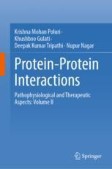Search
Search Results
-
NMR Analysis of Protein Folding Interaction Networks
Theory and experimental evidence unequivocally indicate that protein folding is far more complex than the two-state (all-or-none) model that is...
-
Immunoprecipitation-Mass Spectrometry (IP-MS) of Protein-Protein Interactions of Nuclear-Localized Plant Proteins
Transcription factors that act within a gene regulatory network (GRN) often interact with other proteins such as chromatin remodeling factors,...
-
GraphsformerCPI: Graph Transformer for Compound–Protein Interaction Prediction
Accurately predicting compound–protein interactions (CPI) is a critical task in computer-aided drug design. In recent years, the exponential growth...

-
Chaperone proteins and peroxisomal protein import
Peroxisomes are ubiquitous organelles present in most eukaryotic cells. Their role in cellular metabolism is diverse among species. An array of genes...
-
A protein network refinement method based on module discovery and biological information
BackgroundThe identification of essential proteins can help in understanding the minimum requirements for cell survival and development to discover...

-
A computational exploration of resilience and evolvability of protein–protein interaction networks
Protein–protein interaction (PPI) networks represent complex intra-cellular protein interactions, and the presence or absence of such interactions...

-
Long-distance dependency combined multi-hop graph neural networks for protein–protein interactions prediction
BackgroundProtein–protein interactions are widespread in biological systems and play an important role in cell biology. Since traditional...

-
A supervised protein complex prediction method with network representation learning and gene ontology knowledge
BackgroundProtein complexes are essential for biologists to understand cell organization and function effectively. In recent years, predicting...

-
Regulation of SNARE assembly by protein phosphorylation
Protein phosphorylation is emerging as an important regulatory mechanism that controls the secretory pathway. It enables coupling between the...
-
Golgi-associated retrograde protein (GARP) complex-dependent endosomes to trans Golgi network retrograde trafficking is controlled by Rab4b
BackgroundThe trafficking of cargoes from endosomes to the trans -Golgi network requires numerous sequential and coordinated steps. Cargoes are...

-
The protein-protein interaction ontology: for better representing and capturing the biological context of protein interaction
BackgroundWith the rapid increase in the amount of Protein-Protein Interaction (PPI) data, the establishment of an event-centered PPI ontology that...

-
Pre-trained protein language model sheds new light on the prediction of Arabidopsis protein–protein interactions
BackgroundProtein–protein interactions (PPIs) are heavily involved in many biological processes. Consequently, the identification of PPIs in the...

-
Drug Design Methods to Regulate Protein–Protein Interactions
Inhibiting anomalous protein–protein interactions has led to the discovery of drugs (small molecules, precisely) that can inhibit such interactions...
-
GNNGL-PPI: multi-category prediction of protein-protein interactions using graph neural networks based on global graphs and local subgraphs
Most proteins exert their functions by interacting with other proteins, making the identification of protein-protein interactions (PPI) crucial for...

-
Search, Retrieve, Visualize, and Analyze Protein–Protein Interactions from Multiple Databases: A Guide for Experimental Biologists
Functional annotation is lacking for over half of the proteins encoded in genomes and model or representative organisms are not an exception to this...
-
Peptide and Protein Emulsifiers
There has recently been a growing attention towards peptide and protein molecules as potential bioemulsifiers for the stabilization of foams and...
-
Protein–Protein Interactions in Abiotic Stress Signaling: An Overview of Biochemical and Biophysical Methods of Characterization
The identification and characterization of bona fide abiotic stress signaling proteins can occur at different levels of the complete in vivo...
-
Heterogeneous PPI Network Representation Learning for Protein Complex Identification
Protein complexes are critical units for studying a cell system. How to accurately identify protein complexes has always been the focus of research....
-
Disruptor: Computational identification of oncogenic mutants disrupting protein-protein and protein-DNA interactions
We report an Osprey-based computational protocol to prospectively identify oncogenic mutations that act via disruption of molecular interactions. It...

-
Investigating Plant Protein–Protein Interactions Using FRET-FLIM with a Focus on the Actin Cytoskeleton
The study of protein–protein interactions is fundamental to understanding how actin-dependent processes are controlled through the regulation of...
